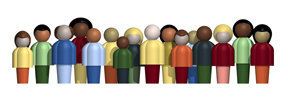If anyone needs proof that Secaucus is changing, consider this: students in the Secaucus School District speak some 16 languages in their homes. In a similar vein, when a major religious figure in India travels annually to visit his followers in the U.S., he stops in Secaucus. Such are the changing demographics of this increasingly diverse town.
When the results of the 2010 U.S. Census, now underway across the country, are complete, Secaucus will get a statistical sense of how much the town is growing and changing.
Beginning next month, households that still haven’t responded may get a visit in person from a census taker.
________
Rooted in community
The one-page Census questionnaire began arriving in homes a month ago and asks the number of residents in each household, their ages, and ethnicity. There is no question regarding citizenship status on the survey.
The deadline to mail the forms back was April 1, but the Census Bureau said people can still mail them in through the end of month.
The Bureau has launched a huge media and advertising campaign this year to get households to respond – and local politicians have followed the bureau’s lead. After all, population information will tell the government how to allocate some $400 billion in funding – spent on roads, parks, and other public services – and where to draw lines for political districts.
“The information collected tells us how certain resources should be allocated, certainly, and you see that in our advertising,” said Yolanda Finley, a media specialist with the Bureau’s New York Regional Office, which includes Hudson County. “But it’s also used for community redistricting, and yes, political districts could be redrawn in Hudson County as a result of this year’s census.”
“I’m certainly interested in having as many people [in Secaucus] as possible respond because it affects our grant money,” said Drumeler. “Nearly every formula grant [from all levels of government] is based on your census data. So, it’s in our best interest, funding-wise, for Secaucus to have an accurate count.”
So far, Secaucus has the highest participation rate among Hudson County towns – 57 percent.
In 2000, the last time the national census was conducted, Secaucus had a reported population of about 16,000. With new development, the number is likely to increase.
Two seeks ago, the Town Council had the clerk read a lengthy letter during its public meeting urging Secaucus residents to mail in their surveys. And Mayor Michael Gonnelli makes the push again in his monthly column in this newspaper.
“We’re trying to come from a position of community engagement, getting people to be rooted in the future of their communities over the next decade by taking 10 minutes to fill out these easy 10 questions,” Finley noted, saying that residents should not see the survey as intrusive or burdensome.
If your forms are late, there’s a fine
Communities that have a history of low response will get a second mailing. Households that returned the first questionnaire need not mail in the second form.
Beginning next month, households that still haven’t responded may get a visit in person from a census taker. Federal law allows the government to fine people who still refuse to answer the questions in person. The fine is a stiff $5,000, but this punishment is rarely used.
“It [the fine] is on the books, but consider this: If we can’t get people to respond to the Census questionnaire, we’d be hard pressed to get them to pay a $5,000 fine,” Finley said. “We’re not invested in coming from a punitive position.”
In addition to the national census survey that’s done once each decade, the Census Bureau also conducts ongoing surveys for other governmental agencies. The Bureau produces data for the Bureau of Labor Statistics, the Department of Education, the National Center for Health, the Department of Housing and Urban Development, among other agencies. The agency also conducts the Survey of Income and Program Participation, the American Housing Survey, economic surveys, and the Census of Foreign Trades.
Finally, the Bureau conducts the American Community Survey that, Finley said, “gets at some the detailed information that was previously on the longer version of the census questionnaire.”
E-mail E. Assata Wright at awright@hudsonreporter.com.
